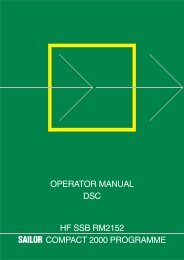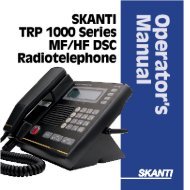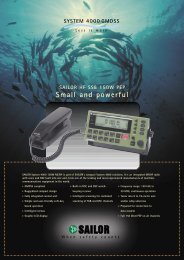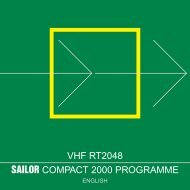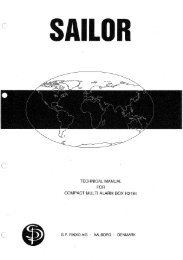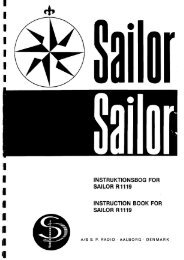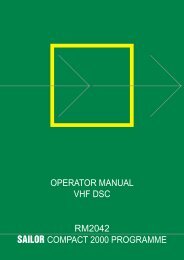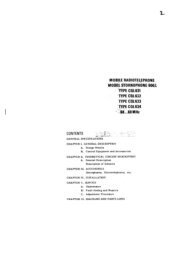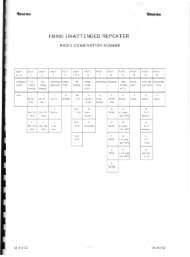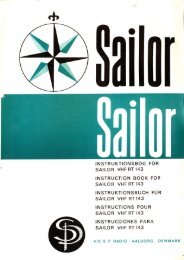TECHNICAL MANUAL FOR COMPACT VHF DSC RM2042
TECHNICAL MANUAL FOR COMPACT VHF DSC RM2042
TECHNICAL MANUAL FOR COMPACT VHF DSC RM2042
You also want an ePaper? Increase the reach of your titles
YUMPU automatically turns print PDFs into web optimized ePapers that Google loves.
5 CIRCUIT DESCRIPTION AND SCHEMATIC DIAGRAMS <strong>RM2042</strong>CIRCUIT SELECT DECODERAll peripheral devices are memory mapped, and can therefore be recognized by their address/addressesin the systems address space. By using address lines A16 to A19 as input to U24, a 4 to 16 line decoder,the address space is divided into 16 64 kbytes pages. Each output 0 to 15 on U24 selects a single 64kbytes memory page. Each peripheral device is placed on the start address of a new 64 kbytes memorypage, and the 16 outputs on U24 is therefore used to chip select the various peripheral devices.As described above, the display uses an M6800 device bus cycle instead of the normal M68HC000 buscycle. The display is, contrary to the other peripheral devices, not equipped with a chip select pin. Thechip select (output no. 7 on U24) is instead used to generate a VPA (valid peripheral device) signal. Whenthe microprocessor has detected the VPA input, it asserts the VMA (valid memory address) output. Thisoutput is gated trough U11.2 along with the E output from the microprocessor and the display chip selectoutput from U24, to form the correct enable pulse E (J4 pin 17) to chip select the display.EPROM MEMORYThe two IC’s U3 and U5 contains the executable program code used by the microprocessor. Since theyoccupy 128 kbytes, equal to two 64 kbytes memory pages, the IC’s are selected when either output 0 oroutput 1 on U24 are at a logical low level.RAM MEMORYThe two IC’s U2 and U4 are used to store intermediate and volatile values used by the microprocessor.EEPROM MEMORYThe IC U1 is the programmable non-volatile memory. The non-volatile memory is used for storingidentification numbers, setup, quick call numbers, station register and received distress messages.PROGRAMMABLE TIMERSU27 contains 3 programmable 16 bit timers. These timers are used to interrupt and hereby control thereal time operation of the microprocessor. OUT0 interrupts with an interval of approx. 13 ms. This timeris however under continuous software control and the time interval cannot be found to be stabile. OUT1is an approx. 1 ms interrupt source. This timer is not under software control and should be stabile.REAL-TIME CLOCKU31 is a battery backed real-time clock. The IC maintains track of time and date. The time is controlledby a 32.768 kHz crystal. The IC interrupts the microprocessor each 10 ms by means of the INTR output.For reference, the 32.768 kHz is output on pin 16 (MFO). The oscillation frequency can be adjusted tothe nominal value by use of C39. When <strong>RM2042</strong> is turned on, and a message appears, telling that thetime has stopped running, the battery may be extinct, and has to be replaced.I/O PORTSThe port IC U22 contains three 8 bit parallel ports, which is used to scan the keyboard, and to control thevarious hardware settings in the the system.Input pin PA0 is used for setting service mode. A low level input sets <strong>RM2042</strong> in service mode.Input pins PA1 - PA7 and output pins PC4 - PC7 are used to scan the 7x4 keyboard matrix. A logical lowpulse on an input pin means a key is currently being pressed.Output pin PB0 controls the keyboard light. A logical high turns the keyboard light on, and a logical lowturns the keyboard light off.Output pins PB1 and PB3 are used to control the signal switch unit on the receiver module.A logical high output on pin PB2 is used to tell the scrambler CRY2001 that the connected <strong>VHF</strong> is onchannel 16.PAGE 5-89341





